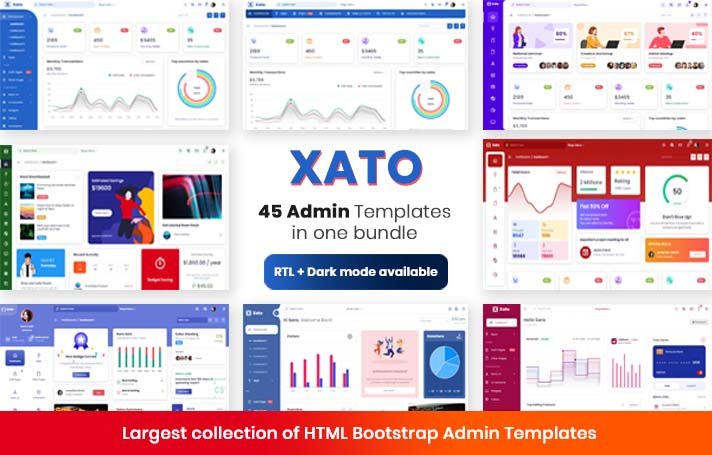Customizing an admin dashboard template is a powerful way to tailor the user interface to specific needs and preferences. To embark on this journey, start by familiarizing yourself with the template’s structure and components. Dive into the code and locate relevant files and folders, understanding their purpose and relationships.
Next, unleash your creativity by modifying colors, typography, and layout elements to align with your desired aesthetic and branding. Take advantage of the template’s built-in features and widgets, or integrate new ones as needed. Fine-tune functionality, such as user permissions and data visualization, to optimize the dashboard’s usability. With attention to detail and experimentation, transform the template into a personalized and efficient admin interface.
How to customize an admin dashboard template
Identify your requirements:
Start by identifying the specific features and functionality that you require in your admin interface. This will help you to determine which parts of the template need to be modified or customized.
Access the source files:
Most admin template are built using HTML, CSS, and JavaScript, so you’ll need to access the source files to make any modifications. You can do this by downloading the template files or accessing them via a content management system (CMS) or web development framework.
Modify the HTML and CSS:
To make changes to the design and layout of the template, you’ll need to modify the HTML and CSS files. This may involve changing the color scheme, adding or removing elements, or rearranging the layout of the interface.
Modify the JavaScript:
If you need to add custom functionality to the template, you’ll need to modify the JavaScript files. This may involve adding custom scripts or plugins to the template to extend its functionality.
Test and refine:
Once you’ve made your modifications, it’s important to thoroughly test the custom template to ensure that it functions as expected. You may need to refine your modifications based on user feedback or performance issues.
Document your changes:
Finally, it’s a good idea to document your customizations so that you can easily maintain and update the template in the future. This may involve creating a documentation file or adding comments to the source code to explain your modifications.
By following these steps, you can customize an admin dashboard template to suit your specific needs and requirements, and create a user-friendly interface that enables you to effectively manage your website, web application, or software.
Tips for designing your own admin dashboard template
Designing your own admin dashboard template can be a rewarding and creative process, but it can also be challenging. Here are some tips to keep in mind when designing your own admin dashboard template:
Define the scope of your project:
Start by defining the scope of your project and the specific features and functionality you want to include in your admin dashboard template. This will help you to focus your efforts and ensure that your template meets your specific needs and requirements.
Use a grid-based layout:
Using a grid-based layout can help you to create a structured and organized interface that is easy to navigate. Consider using a responsive grid system to ensure that your dashboard looks great on all screen sizes and devices.
Keep it simple and intuitive:
When designing your admin dashboard template, aim for simplicity and clarity. Keep the interface intuitive and easy to use, with clear navigation and visual hierarchy.
Use color and typography effectively:
Color and typography are powerful design elements that can help you to create a visually appealing and engaging admin dashboard template. Use color to highlight important information and create a sense of hierarchy, and choose typography that is easy to read and complements the overall design.
Test and iterate:
Once you’ve designed your admin dashboard template, it’s important to test it thoroughly and gather feedback from users. Use this feedback to iterate and refine your design, making improvements and adjustments as needed.
Consider accessibility:
Ensure that your admin dashboard template is accessible to all users, including those with disabilities. Use alt tags for images, ensure that text has sufficient contrast, and use accessible color combinations.
Where to buy an admin dashboard template?
If you’re looking to buy an admin dashboard template, there are many options available online. One great option is Pichforest, which offers a range of high-quality admin dashboard templates for purchase.
Pichforest’s admin dashboard templates are designed with a focus on usability, functionality, and visual appeal. They offer a range of features such as data visualization, user management, content management, and third-party integrations, and come with a range of pre-built layouts and templates that can be customized to meet your specific needs and requirements.
In addition to its extensive collection of admin dashboard templates, Pichforest also offers excellent customer support and documentation, making it easy to get started with your template and customize it to your liking.
Overall, if you’re looking for a reliable and high-quality source to buy an admin dashboard template, Pichforest is definitely worth considering. Their templates are affordable, user-friendly, and customizable, making them a great choice for businesses and individuals alike.
Admin Template is a pre-built dashboard theme that makes it easy and quick to make modern and responsive admin interfaces.


